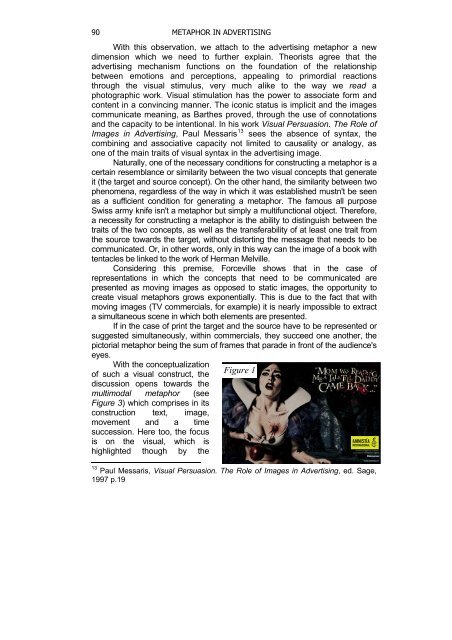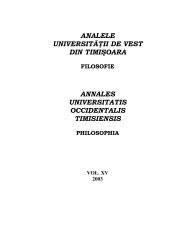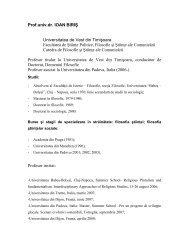VOL. IV (XXI) 2009 - Departamentul de Filosofie si Stiinte ale ...
VOL. IV (XXI) 2009 - Departamentul de Filosofie si Stiinte ale ...
VOL. IV (XXI) 2009 - Departamentul de Filosofie si Stiinte ale ...
You also want an ePaper? Increase the reach of your titles
YUMPU automatically turns print PDFs into web optimized ePapers that Google loves.
90 METAPHOR IN ADVERTISING<br />
With this observation, we attach to the adverti<strong>si</strong>ng metaphor a new<br />
dimen<strong>si</strong>on which we need to further explain. Theorists agree that the<br />
adverti<strong>si</strong>ng mechanism functions on the foundation of the relationship<br />
between emotions and perceptions, appealing to primordial reactions<br />
through the visual stimulus, very much alike to the way we read a<br />
photographic work. Visual stimulation has the power to associate form and<br />
content in a convincing manner. The iconic status is implicit and the images<br />
communicate meaning, as Barthes proved, through the use of connotations<br />
and the capacity to be intentional. In his work Visual Persua<strong>si</strong>on. The Role of<br />
Images in Adverti<strong>si</strong>ng, Paul Messaris 13 sees the absence of syntax, the<br />
combining and associative capacity not limited to causality or analogy, as<br />
one of the main traits of visual syntax in the adverti<strong>si</strong>ng image.<br />
Naturally, one of the necessary conditions for constructing a metaphor is a<br />
certain resemblance or <strong>si</strong>milarity between the two visual concepts that generate<br />
it (the target and source concept). On the other hand, the <strong>si</strong>milarity between two<br />
phenomena, regardless of the way in which it was established mustn't be seen<br />
as a sufficient condition for generating a metaphor. The famous all purpose<br />
Swiss army knife isn't a metaphor but <strong>si</strong>mply a multifunctional object. Therefore,<br />
a neces<strong>si</strong>ty for constructing a metaphor is the ability to distinguish between the<br />
traits of the two concepts, as well as the transferability of at least one trait from<br />
the source towards the target, without distorting the message that needs to be<br />
communicated. Or, in other words, only in this way can the image of a book with<br />
tentacles be linked to the work of Herman Melville.<br />
Con<strong>si</strong><strong>de</strong>ring this premise, Forceville shows that in the case of<br />
representations in which the concepts that need to be communicated are<br />
presented as moving images as opposed to static images, the opportunity to<br />
create visual metaphors grows exponentially. This is due to the fact that with<br />
moving images (TV commercials, for example) it is nearly impos<strong>si</strong>ble to extract<br />
a <strong>si</strong>multaneous scene in which both elements are presented.<br />
If in the case of print the target and the source have to be represented or<br />
suggested <strong>si</strong>multaneously, within commercials, they succeed one another, the<br />
pictorial metaphor being the sum of frames that para<strong>de</strong> in front of the audience's<br />
eyes.<br />
With the conceptualization<br />
of such a visual construct, the<br />
Figure 1<br />
discus<strong>si</strong>on opens towards the<br />
multimodal metaphor (see<br />
Figure 3) which comprises in its<br />
construction text, image,<br />
movement and a time<br />
succes<strong>si</strong>on. Here too, the focus<br />
is on the visual, which is<br />
highlighted though by the<br />
13<br />
Paul Messaris, Visual Persua<strong>si</strong>on. The Role of Images in Adverti<strong>si</strong>ng, ed. Sage,<br />
1997 p.19




